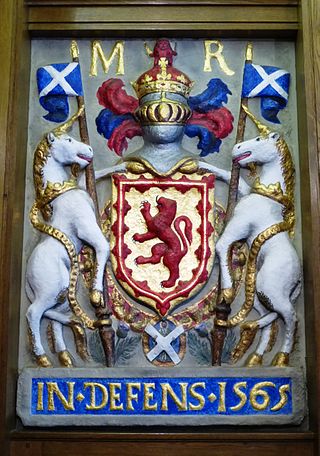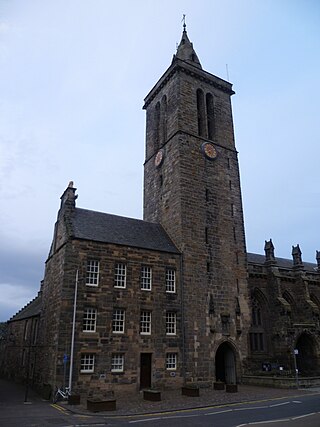
James IV was King of Scotland from 11 June 1488 until his death at the Battle of Flodden in 1513. He inherited the throne at the age of fifteen on the death of his father, James III, at the Battle of Sauchieburn, following a rebellion in which the younger James was the figurehead of the rebels. James IV is generally regarded as the most successful of the Stewart monarchs. He was responsible for a major expansion of the Scottish royal navy, which included the founding of two royal dockyards and the acquisition or construction of 38 ships, including the Michael, the largest warship of its time.

The Lord President of the Court of Session and Lord Justice General is the most senior judge in Scotland, the head of the judiciary, and the presiding judge of the College of Justice, the Court of Session, and the High Court of Justiciary. The Lord President holds the title of Lord Justice General of Scotland and the head of the High Court of Justiciary ex officio, as the two offices were combined in 1836. The Lord President has authority over any court established under Scots law, except for the Supreme Court of the United Kingdom and the Court of the Lord Lyon.

The Court of Session is the supreme civil court of Scotland and constitutes part of the College of Justice; the supreme criminal court of Scotland is the High Court of Justiciary. The Court of Session sits in Parliament House in Edinburgh and is both a trial court and a court of appeal. The court was established in 1532 by an Act of the Parliament of Scotland, and was initially presided over by the Lord Chancellor of Scotland and had equal numbers of clergy and laity. The judges were all appointed from the King's Council. As of May 2017, the Lord President was Lord Carloway, who was appointed on 19 December 2015, and the Lord Justice Clerk was Lady Dorrian, who was appointed on 13 April 2016.

Earl of Carrick is the title applied to the ruler of Carrick, subsequently part of the Peerage of Scotland. The position came to be strongly associated with the Scottish crown when Robert the Bruce, who had inherited it from his maternal kin, became King of Scots in the early 14th century. Since the 15th century, the title of Earl of Carrick has automatically been held by the heir apparent to the throne, thus the current holder of the title is Prince William, Duke of Rothesay.

Andrew Fletcher of Saltoun was a Scottish writer and politician, remembered as an advocate for the non-incorporation of Scotland, and an opponent of the 1707 Act of Union between Scotland and England. Fletcher became an exile in 1683 after being accused of promoting insurrection. He was appointed the cavalry commander of the Monmouth Rebellion, but shortly after landing in England, he killed another leading figure. He again went into exile, this time as a fugitive and with his estates forfeit. He returned with William of Orange, becoming Commissioner of the old Parliament of Scotland.

Succession to the British throne is determined by descent, sex, legitimacy, and religion. Under common law, the Crown is inherited by a sovereign's children or by a childless sovereign's nearest collateral line. The Bill of Rights 1689 and the Act of Settlement 1701 restrict succession to the throne to the legitimate Protestant descendants of Sophia of Hanover who are in "communion with the Church of England". Spouses of Catholics were disqualified from 1689 until the law was amended in 2015. Protestant descendants of those excluded for being Roman Catholics are eligible.

In Scotland a sheriff principal is a judge in charge of a sheriffdom with judicial, quasi-judicial, and administrative responsibilities. Sheriffs principal have been part of the judiciary of Scotland since the 11th century. Sheriffs principal were originally appointed by the monarch of Scotland, and evolved into a heritable jurisdiction before appointment was again vested in the Crown and the monarch of the United Kingdom following the passage of the Heritable Jurisdictions (Scotland) Act 1746.

Scotland in the Middle Ages concerns the history of Scotland from the departure of the Romans to the adoption of major aspects of the Renaissance in the early sixteenth century.
The School Establishment Act 1616 was an Act of the Scottish Privy Council dated 10 December 1616. It mandated the establishment of publicly funded, Church-supervised schools in every parish of Scotland. The act was a consequence of the Scottish Reformation, and was the basis of all future acts of the Parliament of Scotland related to school establishment.

Scotland in the early modern period refers, for the purposes of this article, to Scotland between the death of James IV in 1513 and the end of the Jacobite risings in the mid-eighteenth century. It roughly corresponds to the early modern period in Europe, beginning with the Renaissance and Reformation and ending with the start of the Enlightenment and Industrial Revolution.

The Kingdom of Scotland was a sovereign state in northwest Europe, traditionally said to have been founded in 843. Its territories expanded and shrank, but it came to occupy the northern third of the island of Great Britain, sharing a land border to the south with the Kingdom of England. During the Middle Ages, Scotland engaged in intermittent conflict with England, most prominently the Wars of Scottish Independence, which saw the Scots assert their independence from the English. Following the annexation of the Hebrides and the Northern Isles from Norway in 1266 and 1472 respectively, and the capture of Berwick by England in 1482, the territory of the Kingdom of Scotland corresponded to that of modern-day Scotland, bounded by the North Sea to the east, the Atlantic Ocean to the north and west, and the North Channel and Irish Sea to the southwest.

Scotland in the late Middle Ages, between the deaths of Alexander III in 1286 and James IV in 1513, established its independence from England under figures including William Wallace in the late 13th century and Robert Bruce in the 14th century. In the 15th century under the Stewart Dynasty, despite a turbulent political history, the Crown gained greater political control at the expense of independent lords and regained most of its lost territory to approximately the modern borders of the country. However, the Auld Alliance with France led to the heavy defeat of a Scottish army at the Battle of Flodden in 1513 and the death of the king James IV, which would be followed by a long minority and a period of political instability.

Scots law is the legal system of Scotland. It is a hybrid or mixed legal system containing civil law and common law elements, that traces its roots to a number of different historical sources. Together with English law and Northern Irish law, it is one of the three legal systems of the United Kingdom. Scots law recognises four sources of law: legislation, legal precedent, specific academic writings, and custom. Legislation affecting Scotland and Scots law is passed by the Scottish Parliament on all areas of devolved responsibility, and the United Kingdom Parliament on reserved matters. Some legislation passed by the pre-1707 Parliament of Scotland is still also valid.

The history of Scots law traces the development of Scots law from its early beginnings as a number of different custom systems among Scotland's early cultures to its modern role as one of the three legal jurisdictions of the United Kingdom. The various historic sources of Scots law, including custom, feudal law, canon law, Roman law and English law have created a hybrid or mixed legal system, which shares elements with English law and Northern Irish law but also has its own unique legal institutions and sources.

Government in medieval Scotland, includes all forms of politics and administration of the minor kingdoms that emerged after the departure of the Romans from central and southern Britain in the fifth century, through the development and growth of the combined Scottish and Pictish kingdom of Alba into the kingdom of Scotland, until the adoption of the reforms of the Renaissance in the fifteenth century.

Government in early modern Scotland included all forms of administration, from the crown, through national institutions, to systems of local government and the law, between the early sixteenth century and the mid-eighteenth century. It roughly corresponds to the early modern era in Europe, beginning with the Renaissance and Reformation and ending with the last Jacobite risings and the beginnings of the Industrial Revolution. Monarchs of this period were the Stuarts: James IV, James V, Mary Queen of Scots, James VI, Charles I, Charles II, James VII, William III and Mary II, Anne, and the Hanoverians: George I and George II.

The Cunninghams of Drumquhassle were a family of the landed gentry in Scotland from the early 16th century to the mid-17th. They are linked to the Cunninghams of Kilmaurs in Ayrshire, being descended through junior lines via the Cunninghams of Polmaise. At their greatest extent, their lands included Mugdock-Mitchell and the house at Killermont, covering the part of parishes of Strathblane and New Kilpatrick. John Cunningham, the third laird held several positions of responsibility within the Scottish court, including Master of the Royal Household for James VI and a Collector General of tax during the regency of the Earl of Lennox, but his involvement in the power struggles between the Scottish nobility and the court of Elizabeth I of England also led to his demise and he was executed for treason in 1585. Over the next century, the family lost its land and power – in the mid-17th century, the Cunninghams sold their country house in Drumquhassle in rural Stirlingshire and it passed to the Govane family.

Education in early modern Scotland includes all forms of education within the modern borders of Scotland, between the end of the Middle Ages in the late fifteenth century and the beginnings of the Enlightenment in the mid-eighteenth century. By the sixteenth century such formal educational institutions as grammar schools, petty schools and sewing schools for girls were established in Scotland, while children of the nobility often studied under private tutors. Scotland had three universities, but the curriculum was limited and Scottish scholars had to go abroad to gain second degrees. These contacts were one of the most important ways in which the new ideas of Humanism were brought into Scottish intellectual life. Humanist concern with education and Latin culminated in the Education Act 1496.

Education in Medieval Scotland includes all forms of education within the modern borders of Scotland, between the departure of the Romans from Britain in the fifth century, until the establishment of the Renaissance late fifteenth century and early sixteenth century. Few sources on Scottish education survived the Medieval era. In the early Middle Ages, Scotland was an oral society, with verbal rather than literary education. Though there are indications of a Gaelic education system similar to that of Ireland, few details are known. The establishment of Christianity from the sixth century brought Latin to Scotland as a scholarly and written language. Monasteries served as major repositories of knowledge and education, often running schools.
















